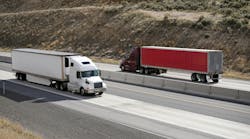The impact of new hours-of-service (HOS) regulations on fleets depends on a variety of factors, not the least of which is whether drivers actually comply with the rules. Carrier type (private, for-hire, etc.), type of freight operation (truckload, less-than-truckload) geographic service area (local, regional, longhaul, etc.), and size must also be taken into consideration.
Under the new rules, large fleets in particular will be affected by waiting time and will need to seek relief — by obtaining improved efficiencies from shippers and receivers or getting more money for their services. In either case, more equipment and drivers will be needed to move the same amount of freight in the same time frame as under the old rules.
Enforcement will be the key to getting cooperation from shippers and receivers. Proposed penalties for violations (up to $11,000 per incident) and scrutiny by enforcement agencies should create an atmosphere where carriers are less willing to haul freight under conditions that could result in HOS violations. Smaller carriers may be more inclined to skirt the boundaries of HOS compliance to gain a competitive advantage.
FOR-HIRE FEELS THE PINCH
More than any other segment, for-hire linehaul operators will feel the impact of the new HOS rules. And if enforcement is as strict as some suggest, many fleets in this sector, especially those with 50-plus vehicles, may decide to install electronic recorders (“black boxes”) for logbook verification, in an effort to avoid unfair judgments calls in the field.
Depending on the cost and difficulty of retrofitting existing equipment, as well as the availability of electronic monitors for retrofit, a move to electronic recordkeeping could have a major impact on trade cycles.
Linehaul fleets that choose to skirt the letter of the law, however, may decide to use owner-operators rather than company drivers. At the same time, higher pay per mile and conditions more conducive to avoiding compliance could make owner-operator status very attractive to many company drivers.
Of course, fleets that use owner-operators will have to deal with issues related to these drivers' “independent” status. Major carriers will have to balance that drawback against the lost productivity caused by new HOS rules.
In terms of the overall need for more drivers and equipment, our analysis shows a reasonably even split between regional and linehaul segments — assuming drivers comply fully with the new rules.
The increase in business-to-business, business-to-consumer, and local spotters for linehaul drop-and-hook operations suggests that demand for equipment and drivers will be strong. Increased equipment needs, as well as a jump in driver pay, means that carriers could be feeling a financial pinch, leading many to consider buying used vehicles.
Since drivers in this segment are usually home at least twice a week, these spots are not as difficult to fill as those in the linehaul segment. As a result, there will be less need to rely on owner-operators or to provide additional equipment to stage freight. But the increased transportation requirements imposed by the new rules will help keep the demand for drivers and equipment strong in this sector.
LOCAL FLEETS CATCH A BREAK
The impact of HOS rules on local fleets will be far less than on OTR fleets. What is unknown, however, is the impact of the rules on local drivers who work for two employers, especially those involved in seasonal work. For example, many local drivers operate snowplows in the winter or haul agricultural products at harvest time, in addition to their primary job.
Although the total number of drivers involved isn't significant, the need to address fatigue in this group may require changes in how employment is reported and tracked by enforcement agencies.
While most construction and off-highway operators currently run within the 14-hour on-duty window, some do exceed the 10-hour driving time. One example would be dump operators whose loading and unloading activities are considered part of driving time. If enforcement is stepped up in these areas, we could see a slight increase in the amount of equipment and drivers needed.
Drivers in the logging business face a more difficult situation because they often take their trucks home at night, which can mean going over the 14-hour on-duty limit. To avoid violations, many will have to alter their operations significantly, e.g., park the truck in an unsecured area and use a personal vehicle to drive back and forth to a work site.
Local P&D operations should be affected only in minor ways. Businesses using the UPS or FedEx model are most likely operating close to current regulations already. However, some may need to go to split-shift operations to take advantage of the time slots customers are available to receive packages. Since drivers would likely be back at the distribution facility working in some other capacity, the new rule will cut into their driving time. At this point, we can't predict how extensive this impact may be.
In general, we don't expect the new HOS rules to have a very significant impact on local operations in terms of the need to hire more drivers or buy more equipment.
Positioning of drivers is another story, however. For example, it's the local drivers who often take care of loading/unloading for linehaul operations, including positioning trailers for drop-and-hook exchanges so the linehaul drivers can get back to their routes with minimal delay.
Initially, carriers will probably continue to have their local personnel carry out this function. But they may eventually decide to opt for joint loading/unloading operations in major metropolitan areas to reduce their investment in local equipment and personnel.
Inefficiencies in the relationships between shippers/receivers and transporters could necessitate a slight increase in the amount of equipment required to handle these local positioning functions.
We expect new HOS regs to have some impact on private carrier productivity. Wal-Mart, for example, believes the rules will reduce drivers' daily hours by about 6%, causing the company to add 275 drivers and 300 trucks to handle the same amount of cargo.
Another area of HOS fallout for private fleets will be a decrease in for-hire carriers' ability to help them meet surges in demand. Fear of missed delivery schedules may be enough to convince private fleets to buy more equipment or extend dedicated contract carriage operations. For-hire carriers will be more willing to provide dedicated capacity than dedicated equipment and drivers.
RETHINKING BACKHAULS
Private carriers that do some “for-hire” hauling will also be affected by the new rules. Getting drivers and equipment back on schedule may actually reduce the amount of for-hire backhaul activity some private fleets can handle.
If backhauling is a financial necessity, however, one solution may be to install more electronic monitoring equipment to enable fleets to schedule drivers “on the fly.” Fleets in this situation will have to weigh the importance of having a driver wait for the available load vs. meeting established delivery schedules for their own products.
A FLEET OWNER columnist, Martin Labbe is president of Martin Labbe Associates, LLC, which provides economic and regulatory analysis for the trucking industry. For a complete copy of this report, including quantitative analysis, go to www.mlabbe.com.
TALKING POINTS
Here's how new HOS rules will most likely impact trucking:
- Some private carriers will increase the size of their linehaul fleet to meet distribution requirements.
- For-hire fleets will increase drop-and-hook operations, requiring use of local drivers and equipment to position linehaul trailers.
- An increase in monitoring efforts could cause some drivers to leave the industry altogether.
- Fleets may find it difficult to hire the number of drivers needed to bring their operations into compliance, which could open the door for regulatory relief.
- Owner-operators will find increased demand for their services, with attractive pay per mile.
- Full compliance will have the greatest financial impact on smaller fleets since they don't have the clout to demand the rate increases necessary to offset the productivity losses resulting from the new rules.


